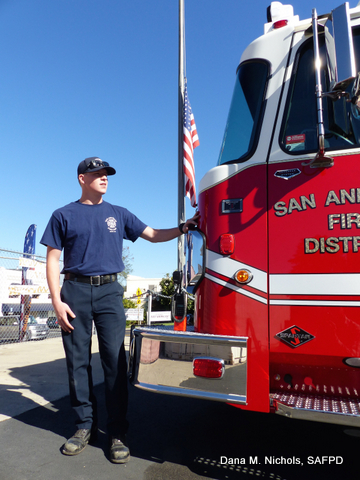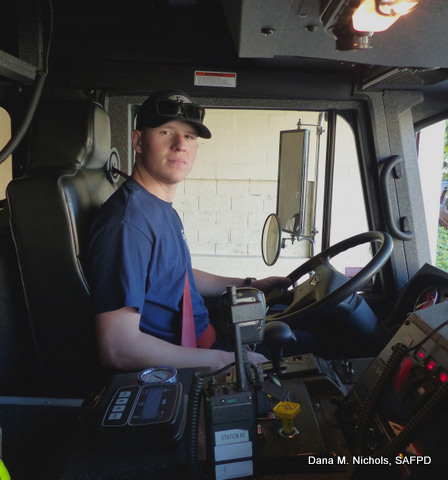San Andreas, CA…The men and women who put out fires in and near San Andreas, extract injured motorists from wrecked cars on area roads and help lift ill people from the floors of San Andreas homes earn only $3.13 an hour for performing that work. And that’s more than it used to be. In August, the San Andreas Fire Protection District Board of Directors boosted the stipend paid to firefighters to $75 for a 24-hour shift. Engineers, who are responsible to drive and operate engines, are paid $100 per 24-hour shift. That works out to just under $3.13 an hour for the firefighters and just under $4.17 an hour for the engineers. Previously, both firefighters and engineers received only $50 per shift.


San Andreas Fire Protection District Engineer Kevin Hall gets paid a stipend of just under $4.17 an hour for his duty shifts at the agency. A federal grant helped the agency to buy the new structure fire engine he can be called upon to drive, but the federal government does not help with the cost of fuel, repairs or pay for fire personnel.
Kevin Hall, 21, already has years of experience as a firefighter but earns only $250 a week in stipends working for San Andreas Fire Protection District. He is looking for permanent, better paid jobs that would allow him to buy a home.
District Chief Don Young said the district board acted to boost pay to keep San Andreas competitive with surrounding districts. Even so, few people can afford to work for so little pay. The district often trains volunteers only to lose them when they get living-wage jobs. Often those jobs are in cities elsewhere in California, making it difficult for volunteers to lend a hand back in San Andreas in their off-duty hours.
“We are just not getting the numbers who want to volunteer on a fire department as we did in years past,” Young said. Decades ago, all of the volunteers serving here, as in many small volunteer districts, lived nearby. During rare emergencies, the station siren would sound and members from all over town would run to the station, Young said. Back in those days, the station was also a social hub complete with a bar.
But times are very different now. Training standards are higher, the number of service calls are higher, and the bar – as well as any tolerance of intoxication on duty – is long gone. Now, the agency tends now to attract young volunteers who come to learn skills that can lead to living-wage jobs elsewhere, Young said. He said that roughly half of the 40 people on the fire department’s roster do not live within the boundaries of the district, which includes San Andreas proper as well as surrounding rural areas.
“We’ve always been a training ground for the larger agencies,” Young said. Young said that volunteers who do remain in the area are sometimes unavailable for calls because they are working shifts at other fire agencies. “A lot of them have joined other departments to make up that pay differential in order to support families,” he said.
Kevin Hall, 21, works as many volunteer shifts as possible for the district under its schedule. That works out to five shifts in each two-week period, yielding him pay of just $250 a week.
Hall commutes from Manteca. (He used to live in Calaveras County but his parents’ home was destroyed in the Butte Fire.) Hall said it costs about $20 to put gas in his car each time he comes for a 48-hour shift. That means that just the gas eats up 10 percent of the $200 he will earn for the shift. How does he survive on $250 a week? “I am still living with my parents,” Hall said. But he is trying to chart a future. “I am trying to get on with an ambulance company now,” Hall said.
Hall is also part of a career-mentoring program with the San Francisco Fire Department. That might someday result in him landing a job with San Francisco or another large agency.
One upside to the low-paid work is that Hall is getting experience driving equipment that would be out of reach for such a young firefighter in the large agencies. A $640,000 federal grant recently allowed San Andreas to purchase an almost $700,000 fire engine.
So Hall, who makes $4.17 an hour, is sometimes the person on call to run a machine worth more than four typical San Andreas houses. He said he values that opportunity and knows someone his age would not get that chance if he was at a big-city agency that paid living wages. “It would take years and years of experience,” he said of how such duties are assigned in places like San Francisco.
Federal dollars may help with equipment purchases, but they do nothing to help pay for gas, repairs or personnel. San Andreas Fire Protection District subsists on an annual budget of about $260,000 per year that comes from local property taxes, Young said. Only two people in the agency – Young and an office manager – receive salaries. Everyone else is a volunteer. And only those volunteers who cover shifts at the station get the stipends. (Captains, who serve as duty officers when Young is not available, get $125 per shift.)
Young says the future of the district is uncertain. Right now, the agency is dipping into reserves to pay the increased stipends. Directors are discussing ways to increase revenue. But it is unclear whether San Andreas voters would be willing to pay more to maintain the fire district’s operations.
“There is not much chance of us continuing to do what we do now without additional funding,” Young said.
Making the problem more difficult is that the district’s call volume continues to grow. Where the agency once went days without a call, now, firefighters typically respond three or four times a day.
The agency set records for call volume two months in a row this summer with 112 calls in July and 118 in August, Young said. The July calls included five structure fires, nine vehicle accidents, 12 wildland fires, and 60 medical calls.
The agency could cut its call volume in half and greatly reduce costs if, for example, it stopped responding to medical calls. Yet Young and other district leaders dislike that idea. And they also are reluctant to cut other services, such as assisting the local hospital when medical transport helicopters land or assisting other fire agencies when called to do so.
Still, despite the difficult financial situation, Young said the recent increase in pay for firefighters was the right thing to do.
“It helped our personnel greatly,” Young said. “They are making peanuts.”



I am so thankful for all firefighters and have much respect. Those men and women deserve to be paid at least min. wages. My personal opinion is it should be much more with the knowledge and skill needed for the engineers. Thank you all for your courageous duties to our communities. God bless you all.